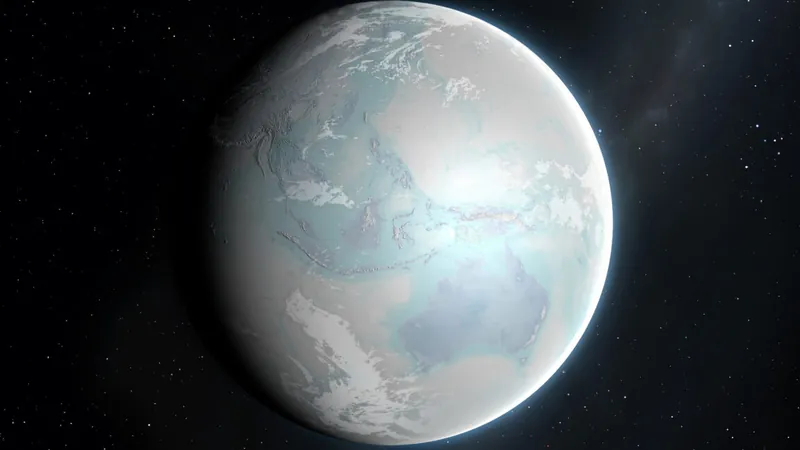
Unveiling the Ice Age: What Did Snowball Earth Really Look Like?
2024-11-13
Author: William
Introduction
About 600 to 700 million years ago, our planet underwent one of the most extreme climate events in its history—a series of global glaciations referred to as "Snowball Earth." This frigid phenomenon is believed to have occurred right before the explosion of complex animal life in the Cambrian period. Climate scientists have confirmed that when a significant portion of the Earth's dark ocean is covered by reflective ice, it initiates a cooling feedback loop that can plunge the entire planet into an icehouse state.
The Challenge of Analyzing Ancient Ice
However, our understanding of what these snow-covered epochs looked like remains incomplete. Antarctic landscapes have offered various simulations of how ice-covered continents might appear, but recent findings have provided new insights. Researchers have identified geological deposits in Colorado's Front Range that they argue were formed beneath an extensive ice sheet, reportedly melted by volcanic activity from below. This was significant, as these deposits were originally much closer to the equator when they formed.
Identifying glacial deposits from such ancient periods poses a significant challenge. Huge ice sheets have the power to scour landscapes to their bare rock, resulting in loosely held rubble that often gets erased once the ice melts. While we can spot remnants of such rubbles in ocean sediment, terrestrial evidence is notably scarcer, complicating the study of these ancient ice ages.
Antarctica offers a complex story: it showcases massive ice sheets but also features dry valleys with minimal precipitation, leading to sublimation rather than accumulation of ice. This duality adds to the difficulty of comprehending what Snowball Earth truly entailed for various continental interiors.
Geologists from the United States have made a groundbreaking discovery in the Tavakaiv sandstones located in the Colorado Rockies. If the researchers' interpretation stands, these formations were created beneath a thick glacial ice layer.
Insights from the Tavakaiv Sandstones
Sandstone deposits can be challenging to date, as they often consist of remnants from ancient rock formations. Nevertheless, the Tavakaiv sandstones are unique, containing intrusions of dark rock that are rich in quartz and hematite, a type of iron oxide. This hematite formation reveals a wealth of information; it suggests that some powerful geological forces were at play, pushing material into fractures in the sandstone. More importantly, hematite traps uranium and lead, providing a method to date the sandstones accurately.
The dating indicated that the sediment layers were formed during the Sturtian glaciation, a crucial glacial period from 715 million to 660 million years ago, when the American continent lay near the equator. Thus, the Tavakaiv sandstones shed light on one continental experience during the drastic global glaciation of the Cryogenian Period.
The authors posit that the hematite was created under extreme pressure from the ice sheet, interacting with liquid water at its base. Potential sources of this water include friction-induced heating, drainage of meltwater, or an ideal combination of temperature and pressure conditions.
Looking Deeper: Volcanic Activity and Geothermal Fluids
Interestingly, the heat required for the formation of hematite typically demands elevated temperatures around 220°C, which doesn’t align well with common theories of glacier water generation. The researchers suggest that volcanic activity was a contributing factor. Relevant volcanic evidence, dated from this era in nearby Idaho, implies that Colorado may have experienced sporadic volcanism, leading to geothermal fluids capable of transporting iron oxides that later formed the hematite observed in the sandstones.
While this discovery indicates that at least one section of the continental interior was icy during Snowball Earth, it doesn't mean that all continental regions experienced the same conditions. As Antarctica illustrates, there can be a coexistence of arid landscapes and expansive ice sheets under certain climatic conditions.
Conclusion
What does this all mean? This crucial finding provides an invaluable peek into an enigmatic chapter of Earth’s climate history, attempting to illuminate a time when the planet was dramatically different, touching on the mysteries that continue to fascinate scientists today. Could this discovery reshape our understanding of Earth’s ancient climates? Stay tuned!









 Brasil (PT)
Brasil (PT)
 Canada (EN)
Canada (EN)
 Chile (ES)
Chile (ES)
 España (ES)
España (ES)
 France (FR)
France (FR)
 Hong Kong (EN)
Hong Kong (EN)
 Italia (IT)
Italia (IT)
 日本 (JA)
日本 (JA)
 Magyarország (HU)
Magyarország (HU)
 Norge (NO)
Norge (NO)
 Polska (PL)
Polska (PL)
 Schweiz (DE)
Schweiz (DE)
 Singapore (EN)
Singapore (EN)
 Sverige (SV)
Sverige (SV)
 Suomi (FI)
Suomi (FI)
 Türkiye (TR)
Türkiye (TR)